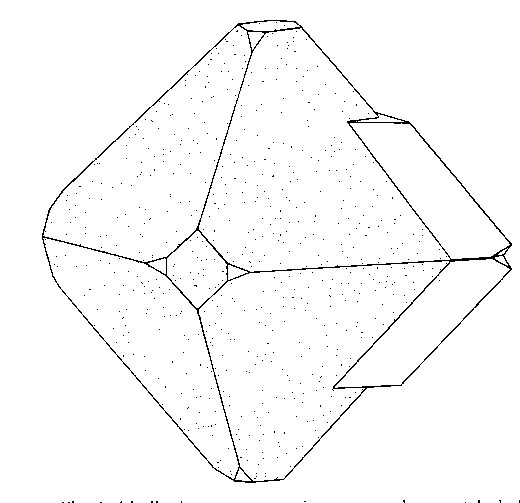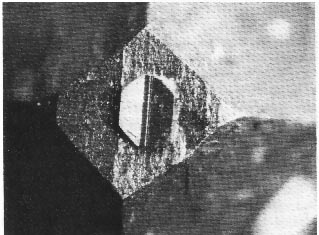| Home | AmMin | GMR | RiMG | Collectors Corner | Directory | Short Courses | |
|
|
|||||||

|
|
Epitaxial marcasite on pyrite from Rensselaer, Indiana KENNETH J. BROCK AND LARRY D. SLATER Department of Geosciences Indiana University Northwest Gary, Indiana 46408 Abstract Epitaxial overgrowths of marcasite on euhedral pyrite occur in petroleum-filled cavities within a northwestern Indiana dolostone quarry. The pyrite substrate consists of octahedra, modified by {100} and {210}, whereas mature marcasite overgrowths appear as twinned prismatic crystals attached along octahedron edges. Marcasite b is parallel to a pyrite crystallographic axis, and marcasite {101} (the composition plane) is parallel to pyrite {100}. Additionally, marcasite composition planes are oriented parallel to striations on underlying cube faces (i.e. parallel to the common edge of cube and pyritohedron faces). This epitaxial arrangement can be attributed to the similarity between the pyrite unit-cell parameter and the two marcasite dimensions, b and (a 2+c2)1/2. The preferential development of marcasite composition planes parallel to cube-face striations provides an arrangement producing the maximum similarity between structures by aligning planar Fe-S chains in marcasite (101) with similar chains in pyrite (010).Introduction Oriented pyrite-marcasite intergrowths are noted frequently in the literature, but as far as we are aware, overgrowths of these two minerals have not been reported previously. The dubious existence of a marcasite stability field renders the occurrence of epitaxial marcasite on pyrite quite remarkable; that is, the overgrowth of a metastable phase on a substrate of its stable polymorph is indeed perplexing2. This paper describes epitaxial marcasite overgrowths on pyrite from a northwestern Indiana stone quarry.Occurrence The overgrowths occur in a dolostone quarry (operated as a source of aggregate) situated in Silurian (?) carbonates approximately three km east of Rensselaer, Indiana. Isolated cavities within the fossiliferous dolostone invariably contain thick petroleum and abundant iron sulfide. Cavity walls are usually lined with masses of intergrown pyrite octahedra or euhedral FeS2 crystals accompanied by calcite or dolomite. Small irregularly-shaped masses of galena also occur rarely.Although field observations are somewhat limited, a general stratigraphic zonation, in which marcasite is largely restricted to the upper strata and pyrite to the lower, appears to prevail within the quarry. Overgrowths are confined to a relatively thin transition region between the two zones, consequently epitaxial marcasite is rather uncommon; however, the occasional cavity that does contain overgrowths may yield several hundred epitaxial crystals. The presence of well-preserved fossils, often intimately intergrown with pyrite or marcasite, implies that the host rock was not subjected to high temperature during deposition of the sulfides. Pyrite typically occurs as dull octahedra modified by (100}, commonly between 2 and 3 cm across; however, individual crystals up to 8 cm in diameter have been noted. Most crystals show minor development of {210}, and traces of {110} are observed in some cases. Cube faces frequently reveal faint striations parallel to the common edges of {100} and {210} faces. 
Fig. 1. Idealized mature marcasite overgrowth on octahedral pyrite (octahedra are typically about 2 cm across). The marcasite is twinned on {101} and the dominant form is (110}. Marcasite b is parallel to pyrite a, and to striations (obscured in the drawing) on the underlying (010) face. Non-epitaxial marcasite occurs as lusterless tabular crystals (up to 2 cm across) that usually display the multiply-twinned cockscomb habit. In contrast, epitaxial marcasite exhibits highly reflective mirror-like faces and is easily recognized by the brilliant luster. Overgrowths are invariably twinned on {101} and vary considerably in maximum dimension and crystal habit. The largest examples consist of distinctly prismatic twin individuals, each of which may approach 1 cm in length. These "mature" overgrowths are attached to the pyrite substrate along octahedron edges, and are joined by twinning across the cube face at the octahedron's apex (Fig. 1). From this maximum size the overgrowths range downward to minute button-like crystals in which the entire twin is less than 1 mm across. These embryonic examples are attached entirely within the confines of a pyrite cube face, and the twin individuals are roughly equant rather than prismatic (Fig. 2). Regardless of their dimensions, the marcasite overgrowths always maintain exactly the same epitaxial relation to the underlying pyrite, suggesting that nucleation occurred on the {100} substrate face and that subsequent crystal growth extended the marcasite prisms along edges of the host octahedron.
Fig. 2. Embryonic epitaxial marcasite overgrowth attached to a pyrite {100} face (overgrowth is approximately 0.3 mm in diameter). Composition plane of the twinned marcasite crystal is parallel to faint striations on underlying cube face. Note orientations of triangular-shaped pyritohedron faces.
Discussion The epitaxial relationship between Rensselaer FeS2 polymorphs is identical to crystallographic orientations commonly reported between natural intergrowths of these minerals, and can undoubtedly be attributed to the similarity between the pyrite unit cell parameter and the two marcasite dimensions, b and (a2 +c2 )1/2. Refined unit-cell parameters were determined for a Rensselaer pyrite crystal and its attached overgrowth; d-spacings were measured from 114.6 mm diameter Debye-Scherrer powder films, and refined using the program of Appleman and Evans (1973). These data yielded a pyrite unit cell of a = 5.417(3) and marcasite unit cell of a = 4.434(2), b = 5.424(1), and c = 3.380(1)A, which gave a calculated percent misfit, between the lattices in epitaxial orientation, of only 1.5 percent.An explanation of the preferred orientation of the marcasite overgrowths follows from the marcasite-pyrite transformation model proposed by Fleet (1970). For overgrowths in which marcasite (101) is parallel to pyrite (010) (Fig. 1), alignment of Fe-S chains in the two structures is maximized when marcasite b is parallel to pyrite al. References Appleman, D. E. and H. T. Evans, Jr. (1973) Job 9214: Indexing and least-squares refinement of powder diffraction data. Natl. Tech. Inf. Serv., U.S. Dept. Commer., Springfield, Virginia Document PB 216 188.Donnay, J. D. H., G. Kullerud and G. Donnay (1971) Crosstwinning as a mechanism of phase transition. Trans. Am. Crystallogr. Assoc., 7, 69-75. Fleet, M. E. (1970) Structural aspects of the marcasite-pyrite transformation. Can. Mineral., 10, 225-231. Footnotes 1Present address: Union Carbide Corporation, Specialty Gas Division, East Chicago, Indiana. 2 If in fact marcasite and pyrite are truly polymorphs; Kullerud (in Donnay et al., 1971) suggests that these two phases may have slightly different compositions.
|
